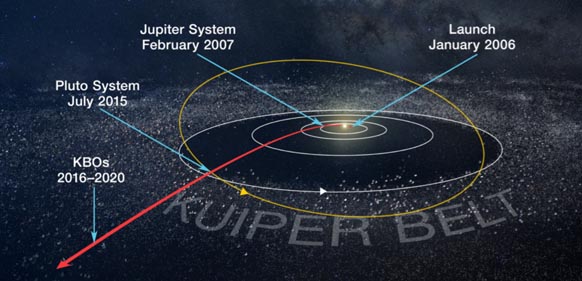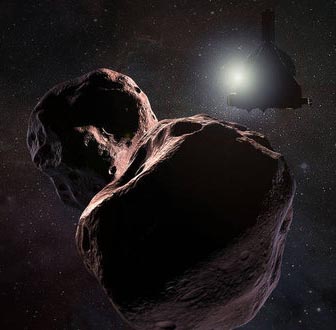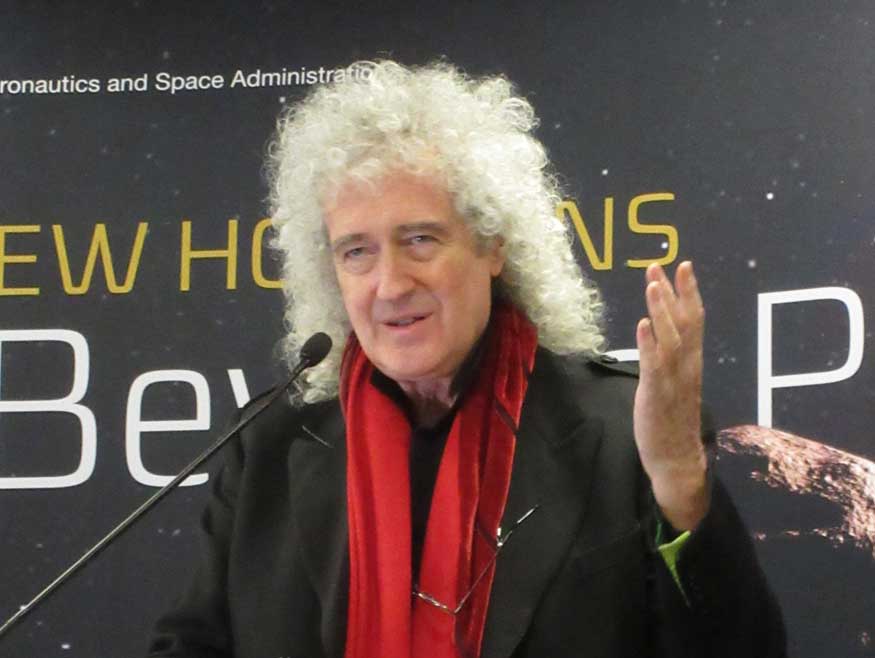NASA's outward-bound explorer rings in the new year with the most distant flyby in space-exploration history.

NASA / JHU-APL / SwRI
In the frigid, silent depths of the Kuiper Belt, the New Horizons spacecraft successfully flew past a tiny world nicknamed "Ultima Thule" (UL-ti-muh THOO-lee), meaning "beyond the known world," in the first hours of 2019. (Its official designation is 2014 MU69.) The highly anticipated flyby, at 5:33 Universal Time today, came 3½ years after the spacecraft's historic encounter with Pluto on July 14, 2015, and occurred some 4.1 billion miles (6.6 billion km) from Earth — the most distant object ever visited at close range.

Steve Gribben / NASA / JHU-APL / SwRI
More than that, the observations from New Horizons' seven experiments, now safely stashed on the craft's solid-state recorders, promise to reveal secrets of the "Third Zone" of the Sun's realm — distant objects that have remained frozen in time since the formation of our solar system's formation 4½ billion years ago.
Confirmation of the flyby's success didn't reach the mission's control center — Johns Hopkins University's Applied Physics Laboratory (JHU-APL) in Laurel, Maryland — for 10 hours. That's because the spacecraft remained out of contact as it scrutinized its target and because its telemetry now takes 6 hours to reach Earth. "We have a healthy spacecraft," announced mission manager Alice Bowman.
Once this "phone home" status report reached the ground, hundreds of anxious mission scientists, news media, and others erupted with applause. "I can't promise you success," principal investigator Alan Stern had warned the day before. "We are straining the capabilities of this spacecraft."
The flyby is also straining the patience of the mission's scientists. By design, the spacecraft returns its observations to Earth very slowly, at no more than 1,000 bits per second, and Stern cautions that the very best images and spectra of 2014 MU69 might not be in hand until February. Highest priority will be transmitting data that reveal the object's geology, its composition, and whether it's surrounded by rings or very small satellites.

NASA / JHU-APL / SwRI
When its closest to 2014 MU69, the spacecraft passed by just 2,200 miles (3,500 km) away, zipping by at 9 miles (14 km) per second. So the encounter was brief and intense. For now, the best view is just a few pixels across, recorded as part of "fail safe" observations taken when New Horizons was still roughly 500,000 miles away.
But that fuzzy view is enough to confirm that "Ultima" is distinctly elongated — shaped like a peanut or, conceivably, two objects orbiting each other very closely — measuring about 22 by 10 miles (35 by 15 km). This shape matches the outcome of three risky occultations, recorded in mid-2017 by telescope-toting observing teams in South America and Africa when the object passed directly in front of faint stars.
Unexpectedly, 2014 MU69 appears to be spinning slowly like a propeller, with its rotation axis pointing roughly toward the Sun. Consequently, despite its irregular shape, the object does not exhibit brightness changes. (This trait was first detected during intensive observations by the Hubble Space Telescope in mid-2017.)
It also suggests that some of the surface remained in shadow as New Horizons approached flew past.

J. Kelly Beatty / Sky & Telescope
The science observations will continue trickling back to Earth, though transmissions will be suspended from January 4th to 7th, when the line of sight to the spacecraft passes close to the Sun. More detailed observations, including the first color views of 2014 MU69, should be available tomorrow, and I'll be reporting on those results too — so check back here soon.
Finally, to underscore how the New Horizons mission has, literally, broadened our scientific horizons, onlookers at JHU-APL were treated to the debut of a song written by Brian May, best known as the guitarist for Queen but who also holds a doctorate in astronomy and serves as a science collaborator (specializing in stereo imagery) with the mission. Have a listen!
 2
2









Comments
george
January 5, 2019 at 3:45 am
"Ultima Thule" (UL-ti-muh TOO-lee),. I don't think anyone speaking English, or studying Latin would pronounce the final 'e' of Thule. Try TOO-l.
This mispronunciation of the final e of words seems to be a fairly common mistake in the USA.
You must be logged in to post a comment.
AB
January 7, 2019 at 10:43 pm
I dunno... couple of dictionaries disagree with you...?
https://www.dictionary.com/browse/ultima-thule
and Thule is Greek.
https://en.wikipedia.org/wiki/Thule
(interesting read)
You must be logged in to post a comment.
You must be logged in to post a comment.